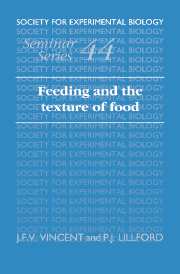Book contents
- Frontmatter
- Contents
- List of contributors
- Introduction
- Mechanical and fracture properties of cellular and fibrous materials
- Texture of plants and fruits
- Measuring meat texture and understanding its structural basis
- Food processing by mastication in cyprinid fish
- Quantitative aspects of the relationship between dentitions and diets
- The control of movements and forces during chewing
- The basic mechanics of mastication: man's adaptive success
- Integrating texture and physiology – techniques
- Brittle textures in processed foods
- The control and generation of texture in soft manufactured foods
- Texture and acceptability of human foods
- Index
The control of movements and forces during chewing
Published online by Cambridge University Press: 14 January 2010
- Frontmatter
- Contents
- List of contributors
- Introduction
- Mechanical and fracture properties of cellular and fibrous materials
- Texture of plants and fruits
- Measuring meat texture and understanding its structural basis
- Food processing by mastication in cyprinid fish
- Quantitative aspects of the relationship between dentitions and diets
- The control of movements and forces during chewing
- The basic mechanics of mastication: man's adaptive success
- Integrating texture and physiology – techniques
- Brittle textures in processed foods
- The control and generation of texture in soft manufactured foods
- Texture and acceptability of human foods
- Index
Summary
When one observes a mammal feeding, its chewing movements give the impression of being well planned, automatic and highly functional. Direct observation, however, does not uncover the immense problems in controlling forces and movements of the jaw, since most of the control parameters (the recruitment patterns of as many as 25 muscle units) remain invisible to the naked eye. A combination of measuring techniques and computer simulation should reach greater depth, although both can be developed and used only under guidance of well-formulated concepts of motor control.
Currently, the field of motor control is largely concentrated on the orchestration of signals, from the nervous system to the periphery and vice versa, which appears to be so complex that the mechanical properties of the muscles and bone–connective-tissue systems involved are not taken into account. A quite different approach is to describe a motor control system as a closed pathway of signals, with branches to the external world. In such a description, the physical expression of the signals changes through the circuit from electrical to mechanical and vice versa, so that the properties of the mechanical section of the pathway play their role in the explanation of motor control. The mechanical properties depend on the architecture of muscles and the bone–connective-tissue system down to the level of filaments. Since this architecture varies according to the space available and the functional demands imposed, it is pointless to use standard values for parameters which describe muscle architecture when calculating movements and forces from recruitment patterns of muscles.
- Type
- Chapter
- Information
- Feeding and the Texture of Food , pp. 123 - 142Publisher: Cambridge University PressPrint publication year: 1991
- 2
- Cited by



